Natural Hazards and Disasters - Malawi Floods 2019: A Poster Analysis
VerifiedAdded on 2022/11/24
|6
|1074
|466
Project
AI Summary
This project is a poster analyzing the 2019 floods in Malawi, detailing the disaster's background, impact, and the government's response. The poster explores the devastating effects on the population, focusing on the socio-economic challenges and loss of life. It examines the National Disaster Risk Management (NDRM) policy, including how it was modified post-disaster, and identifies remaining issues and challenges. The project also discusses the lack of economic diversity, poor infrastructure, and reliance on agriculture, which exacerbate the impact of floods. It highlights the need for effective risk management strategies, climate change measures, and sufficient financial allocation for disaster management to mitigate future impacts. The poster incorporates in-text citations and adheres to APA referencing.
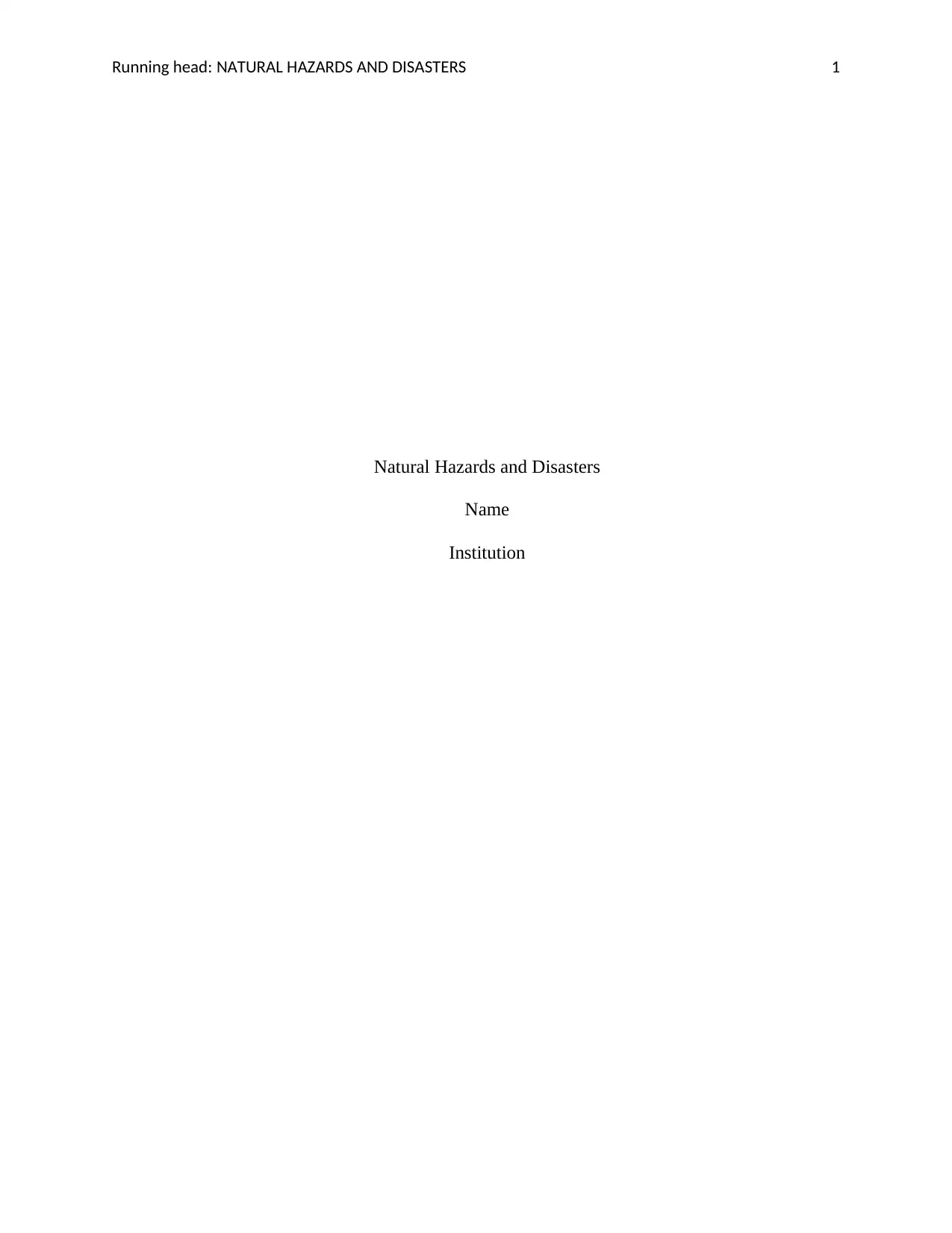
Running head: NATURAL HAZARDS AND DISASTERS 1
Natural Hazards and Disasters
Name
Institution
Natural Hazards and Disasters
Name
Institution
Paraphrase This Document
Need a fresh take? Get an instant paraphrase of this document with our AI Paraphraser
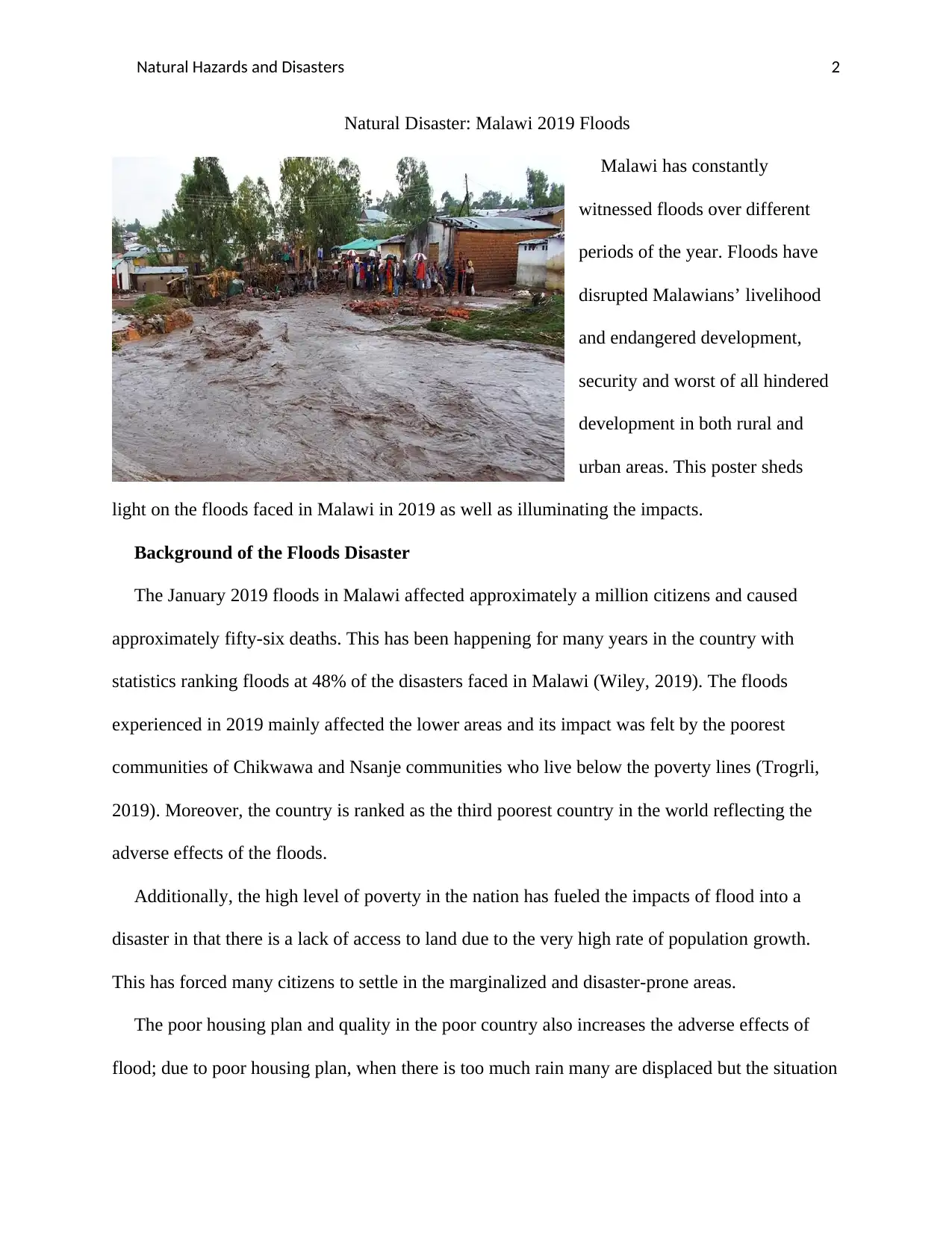
Natural Hazards and Disasters 2
Natural Disaster: Malawi 2019 Floods
Malawi has constantly
witnessed floods over different
periods of the year. Floods have
disrupted Malawians’ livelihood
and endangered development,
security and worst of all hindered
development in both rural and
urban areas. This poster sheds
light on the floods faced in Malawi in 2019 as well as illuminating the impacts.
Background of the Floods Disaster
The January 2019 floods in Malawi affected approximately a million citizens and caused
approximately fifty-six deaths. This has been happening for many years in the country with
statistics ranking floods at 48% of the disasters faced in Malawi (Wiley, 2019). The floods
experienced in 2019 mainly affected the lower areas and its impact was felt by the poorest
communities of Chikwawa and Nsanje communities who live below the poverty lines (Trogrli,
2019). Moreover, the country is ranked as the third poorest country in the world reflecting the
adverse effects of the floods.
Additionally, the high level of poverty in the nation has fueled the impacts of flood into a
disaster in that there is a lack of access to land due to the very high rate of population growth.
This has forced many citizens to settle in the marginalized and disaster-prone areas.
The poor housing plan and quality in the poor country also increases the adverse effects of
flood; due to poor housing plan, when there is too much rain many are displaced but the situation
Natural Disaster: Malawi 2019 Floods
Malawi has constantly
witnessed floods over different
periods of the year. Floods have
disrupted Malawians’ livelihood
and endangered development,
security and worst of all hindered
development in both rural and
urban areas. This poster sheds
light on the floods faced in Malawi in 2019 as well as illuminating the impacts.
Background of the Floods Disaster
The January 2019 floods in Malawi affected approximately a million citizens and caused
approximately fifty-six deaths. This has been happening for many years in the country with
statistics ranking floods at 48% of the disasters faced in Malawi (Wiley, 2019). The floods
experienced in 2019 mainly affected the lower areas and its impact was felt by the poorest
communities of Chikwawa and Nsanje communities who live below the poverty lines (Trogrli,
2019). Moreover, the country is ranked as the third poorest country in the world reflecting the
adverse effects of the floods.
Additionally, the high level of poverty in the nation has fueled the impacts of flood into a
disaster in that there is a lack of access to land due to the very high rate of population growth.
This has forced many citizens to settle in the marginalized and disaster-prone areas.
The poor housing plan and quality in the poor country also increases the adverse effects of
flood; due to poor housing plan, when there is too much rain many are displaced but the situation
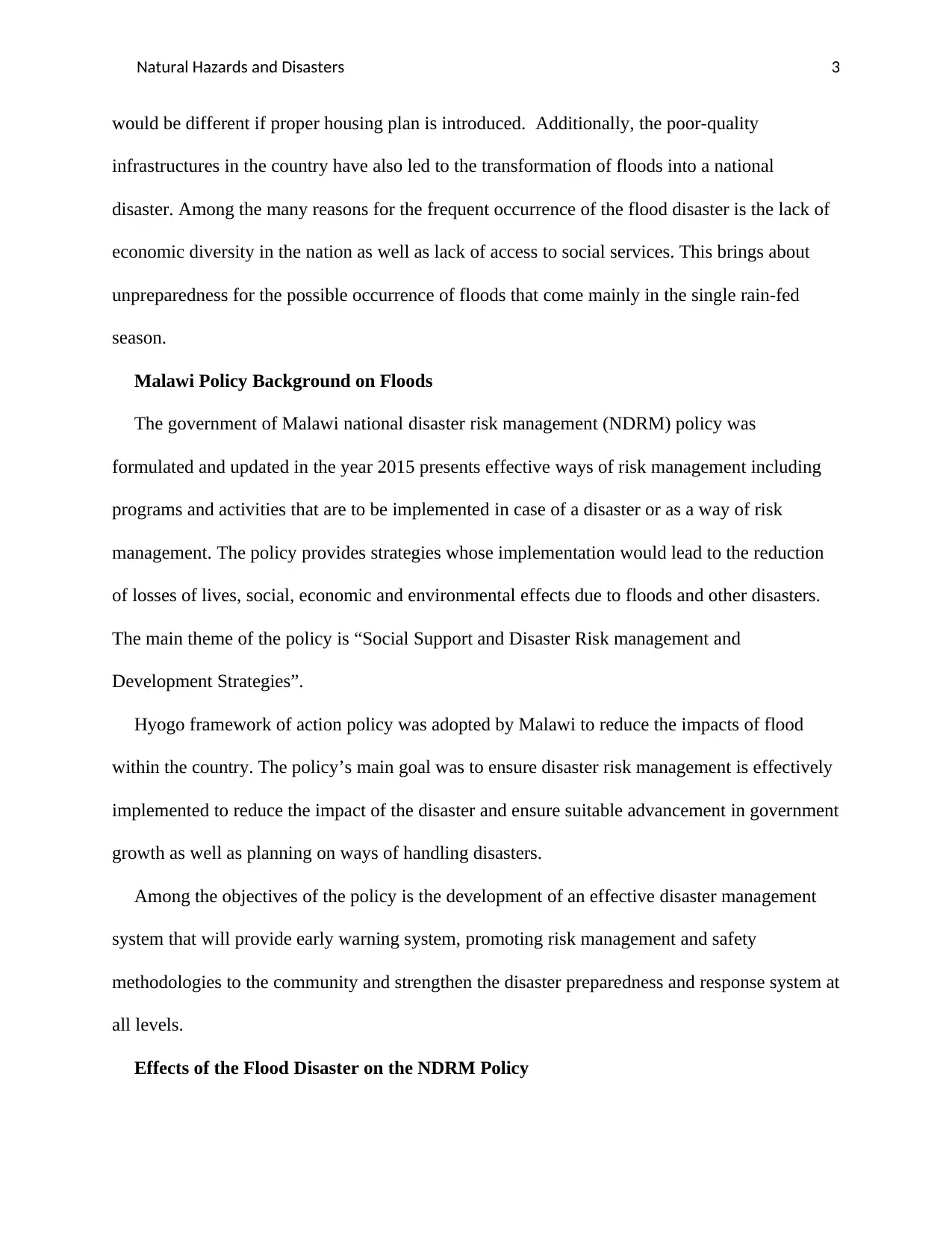
Natural Hazards and Disasters 3
would be different if proper housing plan is introduced. Additionally, the poor-quality
infrastructures in the country have also led to the transformation of floods into a national
disaster. Among the many reasons for the frequent occurrence of the flood disaster is the lack of
economic diversity in the nation as well as lack of access to social services. This brings about
unpreparedness for the possible occurrence of floods that come mainly in the single rain-fed
season.
Malawi Policy Background on Floods
The government of Malawi national disaster risk management (NDRM) policy was
formulated and updated in the year 2015 presents effective ways of risk management including
programs and activities that are to be implemented in case of a disaster or as a way of risk
management. The policy provides strategies whose implementation would lead to the reduction
of losses of lives, social, economic and environmental effects due to floods and other disasters.
The main theme of the policy is “Social Support and Disaster Risk management and
Development Strategies”.
Hyogo framework of action policy was adopted by Malawi to reduce the impacts of flood
within the country. The policy’s main goal was to ensure disaster risk management is effectively
implemented to reduce the impact of the disaster and ensure suitable advancement in government
growth as well as planning on ways of handling disasters.
Among the objectives of the policy is the development of an effective disaster management
system that will provide early warning system, promoting risk management and safety
methodologies to the community and strengthen the disaster preparedness and response system at
all levels.
Effects of the Flood Disaster on the NDRM Policy
would be different if proper housing plan is introduced. Additionally, the poor-quality
infrastructures in the country have also led to the transformation of floods into a national
disaster. Among the many reasons for the frequent occurrence of the flood disaster is the lack of
economic diversity in the nation as well as lack of access to social services. This brings about
unpreparedness for the possible occurrence of floods that come mainly in the single rain-fed
season.
Malawi Policy Background on Floods
The government of Malawi national disaster risk management (NDRM) policy was
formulated and updated in the year 2015 presents effective ways of risk management including
programs and activities that are to be implemented in case of a disaster or as a way of risk
management. The policy provides strategies whose implementation would lead to the reduction
of losses of lives, social, economic and environmental effects due to floods and other disasters.
The main theme of the policy is “Social Support and Disaster Risk management and
Development Strategies”.
Hyogo framework of action policy was adopted by Malawi to reduce the impacts of flood
within the country. The policy’s main goal was to ensure disaster risk management is effectively
implemented to reduce the impact of the disaster and ensure suitable advancement in government
growth as well as planning on ways of handling disasters.
Among the objectives of the policy is the development of an effective disaster management
system that will provide early warning system, promoting risk management and safety
methodologies to the community and strengthen the disaster preparedness and response system at
all levels.
Effects of the Flood Disaster on the NDRM Policy
⊘ This is a preview!⊘
Do you want full access?
Subscribe today to unlock all pages.

Trusted by 1+ million students worldwide
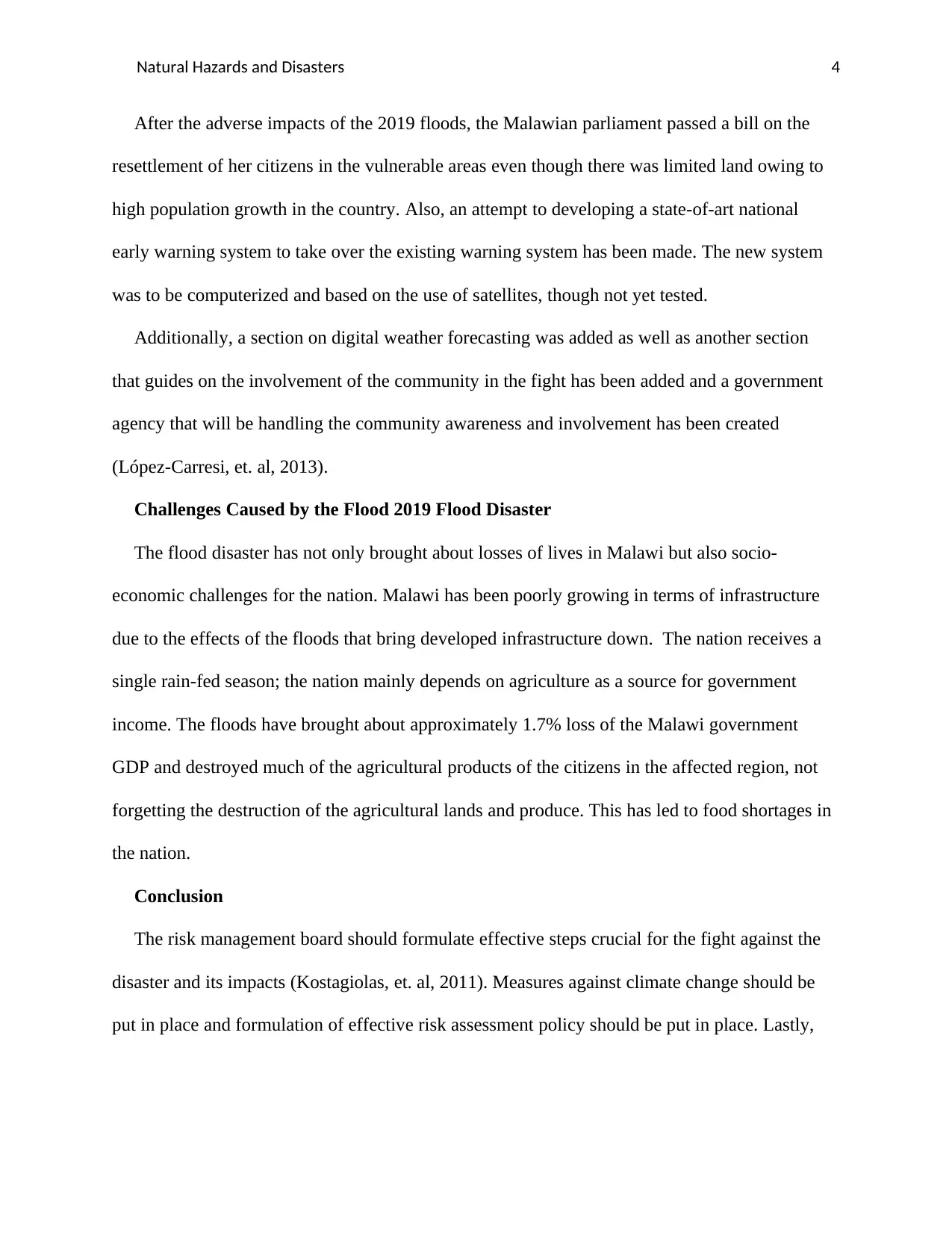
Natural Hazards and Disasters 4
After the adverse impacts of the 2019 floods, the Malawian parliament passed a bill on the
resettlement of her citizens in the vulnerable areas even though there was limited land owing to
high population growth in the country. Also, an attempt to developing a state-of-art national
early warning system to take over the existing warning system has been made. The new system
was to be computerized and based on the use of satellites, though not yet tested.
Additionally, a section on digital weather forecasting was added as well as another section
that guides on the involvement of the community in the fight has been added and a government
agency that will be handling the community awareness and involvement has been created
(López-Carresi, et. al, 2013).
Challenges Caused by the Flood 2019 Flood Disaster
The flood disaster has not only brought about losses of lives in Malawi but also socio-
economic challenges for the nation. Malawi has been poorly growing in terms of infrastructure
due to the effects of the floods that bring developed infrastructure down. The nation receives a
single rain-fed season; the nation mainly depends on agriculture as a source for government
income. The floods have brought about approximately 1.7% loss of the Malawi government
GDP and destroyed much of the agricultural products of the citizens in the affected region, not
forgetting the destruction of the agricultural lands and produce. This has led to food shortages in
the nation.
Conclusion
The risk management board should formulate effective steps crucial for the fight against the
disaster and its impacts (Kostagiolas, et. al, 2011). Measures against climate change should be
put in place and formulation of effective risk assessment policy should be put in place. Lastly,
After the adverse impacts of the 2019 floods, the Malawian parliament passed a bill on the
resettlement of her citizens in the vulnerable areas even though there was limited land owing to
high population growth in the country. Also, an attempt to developing a state-of-art national
early warning system to take over the existing warning system has been made. The new system
was to be computerized and based on the use of satellites, though not yet tested.
Additionally, a section on digital weather forecasting was added as well as another section
that guides on the involvement of the community in the fight has been added and a government
agency that will be handling the community awareness and involvement has been created
(López-Carresi, et. al, 2013).
Challenges Caused by the Flood 2019 Flood Disaster
The flood disaster has not only brought about losses of lives in Malawi but also socio-
economic challenges for the nation. Malawi has been poorly growing in terms of infrastructure
due to the effects of the floods that bring developed infrastructure down. The nation receives a
single rain-fed season; the nation mainly depends on agriculture as a source for government
income. The floods have brought about approximately 1.7% loss of the Malawi government
GDP and destroyed much of the agricultural products of the citizens in the affected region, not
forgetting the destruction of the agricultural lands and produce. This has led to food shortages in
the nation.
Conclusion
The risk management board should formulate effective steps crucial for the fight against the
disaster and its impacts (Kostagiolas, et. al, 2011). Measures against climate change should be
put in place and formulation of effective risk assessment policy should be put in place. Lastly,
Paraphrase This Document
Need a fresh take? Get an instant paraphrase of this document with our AI Paraphraser
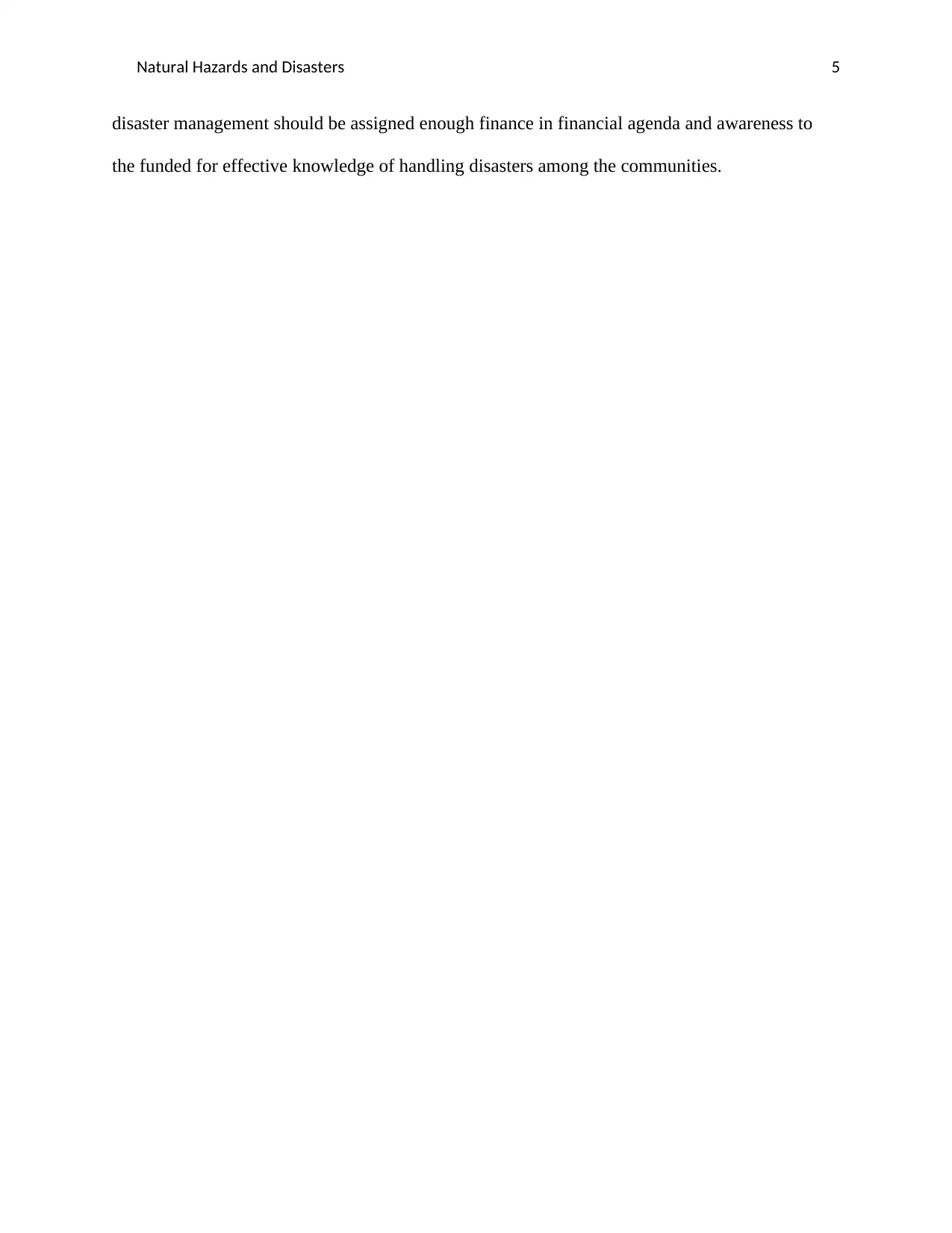
Natural Hazards and Disasters 5
disaster management should be assigned enough finance in financial agenda and awareness to
the funded for effective knowledge of handling disasters among the communities.
disaster management should be assigned enough finance in financial agenda and awareness to
the funded for effective knowledge of handling disasters among the communities.
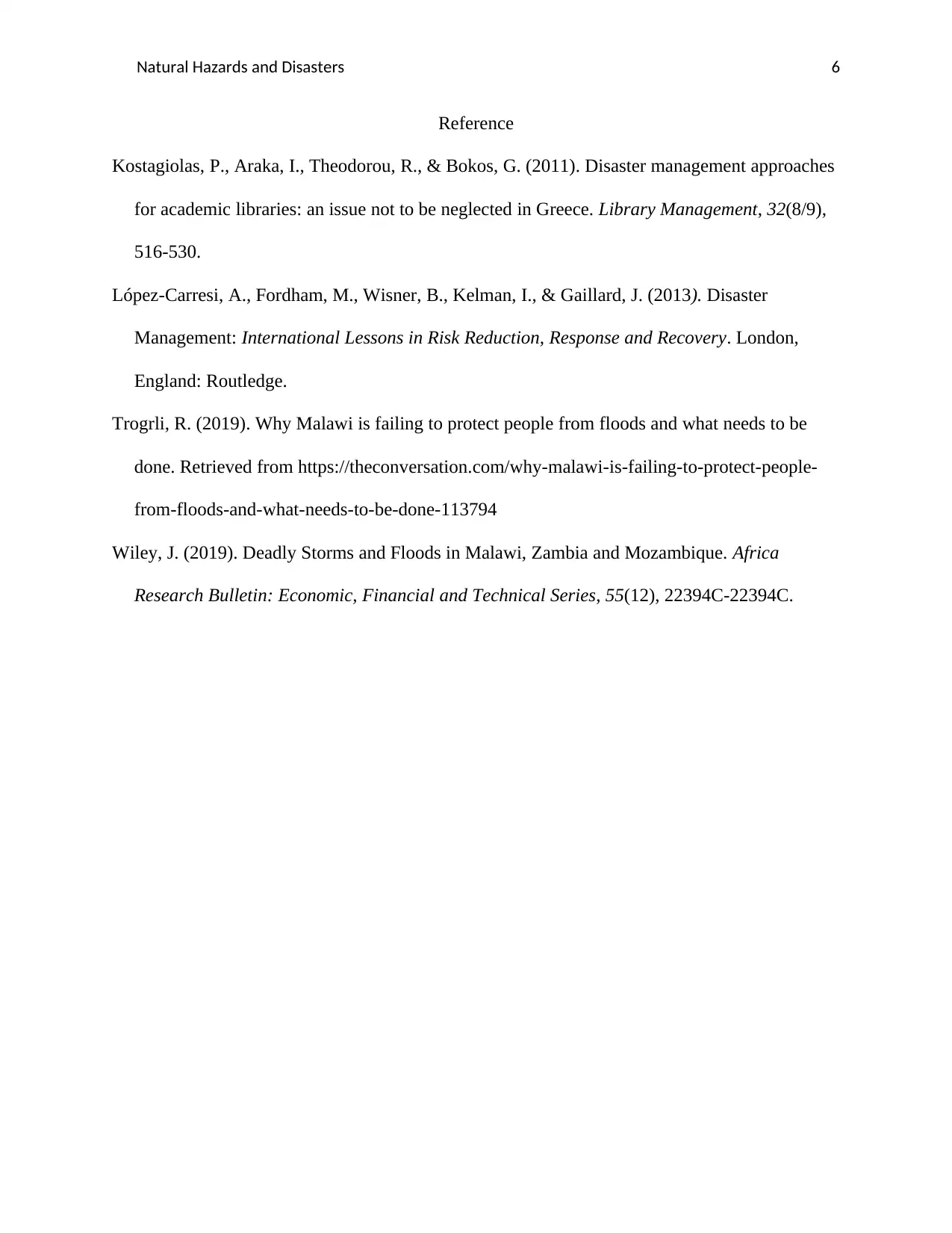
Natural Hazards and Disasters 6
Reference
Kostagiolas, P., Araka, I., Theodorou, R., & Bokos, G. (2011). Disaster management approaches
for academic libraries: an issue not to be neglected in Greece. Library Management, 32(8/9),
516-530.
López-Carresi, A., Fordham, M., Wisner, B., Kelman, I., & Gaillard, J. (2013). Disaster
Management: International Lessons in Risk Reduction, Response and Recovery. London,
England: Routledge.
Trogrli, R. (2019). Why Malawi is failing to protect people from floods and what needs to be
done. Retrieved from https://theconversation.com/why-malawi-is-failing-to-protect-people-
from-floods-and-what-needs-to-be-done-113794
Wiley, J. (2019). Deadly Storms and Floods in Malawi, Zambia and Mozambique. Africa
Research Bulletin: Economic, Financial and Technical Series, 55(12), 22394C-22394C.
Reference
Kostagiolas, P., Araka, I., Theodorou, R., & Bokos, G. (2011). Disaster management approaches
for academic libraries: an issue not to be neglected in Greece. Library Management, 32(8/9),
516-530.
López-Carresi, A., Fordham, M., Wisner, B., Kelman, I., & Gaillard, J. (2013). Disaster
Management: International Lessons in Risk Reduction, Response and Recovery. London,
England: Routledge.
Trogrli, R. (2019). Why Malawi is failing to protect people from floods and what needs to be
done. Retrieved from https://theconversation.com/why-malawi-is-failing-to-protect-people-
from-floods-and-what-needs-to-be-done-113794
Wiley, J. (2019). Deadly Storms and Floods in Malawi, Zambia and Mozambique. Africa
Research Bulletin: Economic, Financial and Technical Series, 55(12), 22394C-22394C.
⊘ This is a preview!⊘
Do you want full access?
Subscribe today to unlock all pages.

Trusted by 1+ million students worldwide
1 out of 6
Related Documents
Your All-in-One AI-Powered Toolkit for Academic Success.
+13062052269
info@desklib.com
Available 24*7 on WhatsApp / Email
![[object Object]](/_next/static/media/star-bottom.7253800d.svg)
Unlock your academic potential
Copyright © 2020–2025 A2Z Services. All Rights Reserved. Developed and managed by ZUCOL.





